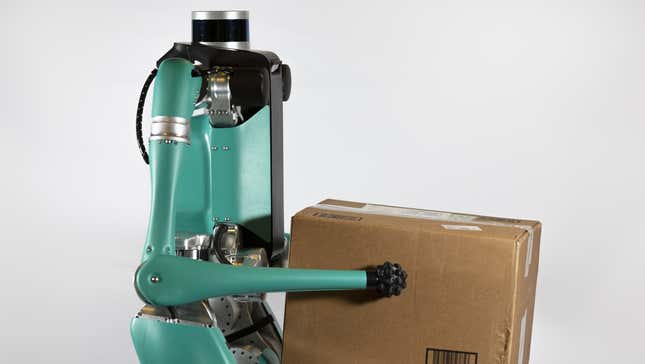
That bipedal humanoid robot is named Digit. Say goodbye now, because you’ll never see one in person.
Agility Robotics announced an ambitious partnership today with Ford to tackle the most labor-intensive portion of package delivery: the so-called “last mile” from small, local warehouses to their end destination. Where Digit supposedly comes in is what Ford CTO Ken Washington called “the last 50 feet”—from a vehicle to the actual doorstep.
Yup, the plan is to shove an autonomous robot in the trunk of an autonomous robot car, eliminating the need for human labor completely.

Last mile has become a war zone in recent years, as e-commerce has grown and labor norms have eroded. The pressure of contractor-model delivery has even led to discussions of two-tier systems that include contingent and unionized workers to do similar work at the same company. Of course, automation is considered less of a moonshot than an eventual path to better margins for the CEOs running these companies—with Uber notably relying on AVs as a means to reduce overhead (see: pay for drivers) in the near future, and Amazon feeling optimistic about its investment in self-driving car startup Aurora.
But Ford, not long after opening an autonomous vehicle plant in Michigan, said last month that it had been too bullish on the prospect. CEO Jim Hackett was quoted as saying the company “overestimated the arrival of autonomous vehicles,” and that near-term “applications will be narrow, what we call geo-fenced, because the problem is so complex.” The company is still committed to having “a fully autonomous vehicle in commercial operation” by 2021 and 100 AVs on the road by the end of this year.
Digit too is likely not prepared for the specific challenges involved in the fairly simple human task of moving a box from point A to a very close point B. It’s predecessor bot, Cassie, was impressive, but from a robotic mobility perspective (it can ride a segway, sort of) rather than a practical, commercial one. Without sensors of any kind, it’s both blind and operating under the assumption that “the world is flat,” according to an Agility Robotics video from this February. “Unfortunately at some point the complexity of the world exceeds what the gait can accommodate,” a researcher says in the clip—complexity here being represented by stairs, a fixture of basically every home’s front entrance.
Granted, Digit has a Lidar puck for a head, optical sensors, and will supposedly be able to receive mapping data from its accompanying vehicle. Counterpoint: here’s several, much simpler robots floundering in standard city environments, and here are a bunch of AVs crashing or killing pedestrians.
The amount of money being poured into robotizing the movement of stuff makes full automation feel inevitable. Maybe it is. But there are an awful lot of kinks to work out. If a system like Ford’s is ever ready for prime-time, Digit will be, at best, a distant prototype for what rolls out to consumers.